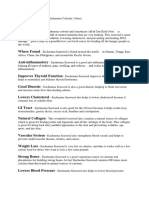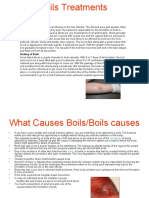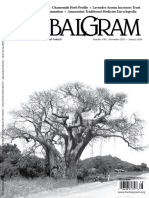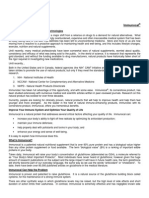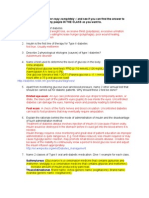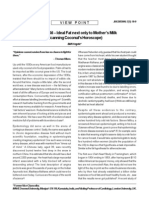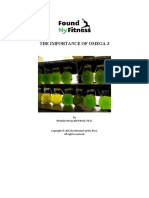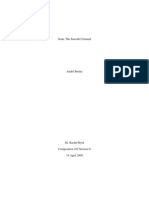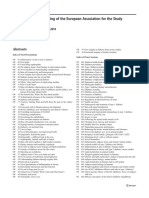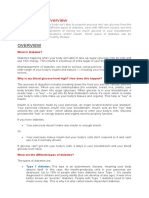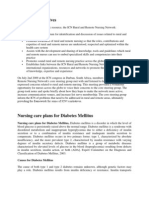Herb For Diabetes
Herb For Diabetes
Uploaded by
RakeshKumarCopyright:
Available Formats
Herb For Diabetes
Herb For Diabetes
Uploaded by
RakeshKumarOriginal Description:
Original Title
Copyright
Available Formats
Share this document
Did you find this document useful?
Is this content inappropriate?
Copyright:
Available Formats
Herb For Diabetes
Herb For Diabetes
Uploaded by
RakeshKumarCopyright:
Available Formats
ISSN: 2277- 7695
CODEN Code: PIHNBQ
ZDB-Number: 2663038-2
IC Journal No: 7725
Vol. 2 No. 5 2013
Online Available at www.thepharmajournal.com
THE PHARMA INNOVATION - JOURNAL
Formulation and Evaluation of Herbal Anti-diabetic
Formulation Containing Eugenia jambolana, Gymnema
sylvestre, Tinospora cordifolia, Pterocarpus marscipum,
Terminalia bellerica & Emblica officinalis
Ritesh Arora 1*, Anuj Mittal 1, Keshari Kishore Jha 1
1.
Teerthanker Mahaveer College of Pharmacy, TMU, Moradabad
[E-mail: cool.ritesharora@gmail.com]
Diabetes mellitus is the commonest endocrine disorder that affects more than 100 million people worldwide (6% of
the population). It is caused by the deficiency or ineffective production of insulin by pancreas which result in
increase or decrease in concentration of glucose in the blood. Due to various drawbacks of synthetic antidiabetic
drugs there is a continuous search for alternative therapy in diabetes. Many herbal plants with hypoglycemic
properties are known for a long time and they are used traditionally in India. Present study was conducted to
formulate a suitable dosage form and used traditionally such as Eugenia jambolana, Gymnema sylvestre, Tinospora
cordifolia, Pterocarpus marscipum, Terminalia bellerica are most of the effective and the most commonly studied
Indian plants in relation to diabetes.
Keyword: Diabetes Mellitus, Hypoglycaemic, Herbal Medicines, Allopathic Drugs, Ayurveda.
1. Introduction
The word diabetes was coined by the Greek
physician Aretaeus in the first century AD
Diabetes mellitus has been known since ages and
sweetness of urine has been mentioned in
Ayurveda by Sushruta. Its pharmacotherapy is 80
year old. The presence of sugar in the urine of
diabetics was demonstrated by Dobson in 1755[1].
Diabetes mellitus is a clinical syndrome
characterized by inappropriate hyperglycemia
caused by a relative or absolute deficiency of
insulin or by a resistance to the action of insulin
at cellular level. It is the most common endocrine
disorder, affecting 100 million individuals
worldwide[2].
Insulin is polypeptide hormone produced by the
-cells of islets of Langerhans of pancreas and is
main key for metabolism of carbohydrate, fats
Vol. 2 No. 5 2013
and proteins. It is anabolic hormone and promotes
synthesis of glycogen, tricylglycerols and
proteins. Human insulin has molecular weight
5734 and contains 51 amino acid in two
polypeptides chains. The chain A has 21 amino
acids and chain B has 30 amino acids. These
chains held together by two inter chain disulfide
bridges[3]. Acute complications include diabetic
ketoacidosis, nonketotic hyperosmolar coma, and
diabetic coma. In case of chronic complication,
chronic elevation of blood glucose level leads to
damage to blood vessels. In diabetes, the resultant
problems are grouped under "micro vascular
disease (due to damage to small blood vessels)
and "macro vascular disease" (due to damage to
the arteries)[4].
There are different approaches to the treatment of
diabetes, like insulin treatment in type 1 diabetes:
www.thepharmajournal.com
Page | 210
The Pharma Innovation - Journal
Sulphonylureas, which release insulin from
pancreas by blocking the ATP-sensitive
potassium channels[5]; Biguanides which decrease
the insulin resistance; Thiazolidinediones, which
increase the insulin sensitivity; alpha-glucosidase
inhibitors like acarbose which decrease glucose
absorption from intestine, thereby decreasing
postprandial hyperglycemia; meglitinides like
rapaglinide which are insulin secretogoues.
Traditional herbal mineral plays an important part
in the treatment of diabetes. If research was able
to even identify some 5-6 herbal drugs that can
reduce dose of insulin by increasing resistance
sensitivity, reducing insulin resistance, then it is
possibly contributes in the treatment of diabetes.
Herbal medicines are often used as therapeutic
remedies in combination with allopathic drugs[6].
1.1 Etiology of Diabetes, Cure and Strategy
Diabetic patients are diagnosed by blood or
urinary glucose measurement through different
techniques. On the basis of etiology DM
(Diabetes mellitus) are categories mainly two
types viz:
1. Primary Diabetes (Type I or Insulin
Dependent Diabetes Mellitus).
2. Secondary Diabetes (Type II or Non
insulin Dependent Diabetes Mellitus).
Primary DM (Diabetes mellitus) clinically
dependent on insulin due to there is decrease in
the number of -cells in the islets of Langerhans
and thus there is absolute deficiency of insulin
hence this is known as Insulin Dependent
Diabetes Mellitus (IDDM) or Type I. The main
treatment for this Type I of DM (Diabetes
mellitus) is insulin.
Secondary DM (Diabetes mellitus) is referred as
Type II or Non Insulin Dependent Diabetes
Mellitus (NIDDM) because these types of
patients are insulin resistances as well as loss of
insulin secretion contributes to the onset of
disease. The patients are usually obese and the
treatment
is
usually
dietary,
through
[7]
supplementary oral hypoglycemic drugs .
1.2 Strategy for Treatment of Diabetes
Basic therapeutic approach to treat diabetes may
be to inhibit the absorption of glucose by
Vol. 2 No. 5 2013
retarding the action of gastrointestinal enzymes
such as -glucosidase and -amylase. Because
the complication of disease is mainly due to the
higher glucose level in blood which dysfunction
the other organs of body. Thus we can say that
the effective -glucosidase inhibitors may serves
as chemotherapeutic agents for clinic use in the
treatment of diabetes and obesity[8].
1.3 Medicine for Treatment of Diabetes
Mellitus
1.3.1. Insulin
Insulin increases glucose uptake in cells by
stimulating the translocation of the glucose
transporter GLUT4 from intracellular sites to the
cell surface[9]. Insulin circulates in blood as the
free monomer and its half life in plasma is about
5 - 6 min in normal subjects. Although glucose is
the principal stimulus to insulin secretion in
human beings, this process is tightly regulated by
the coordinated of nutrients, gastrointestinal and
pancreatic
hormones
and
autonomic
neurotransmitters[10]. The main drawback of
insulin is taken through injection.
1.3.2. Oral Hypoglycemic Drugs
Oral Hypoglycemic drugs are those drugs that
lower blood glucose level and taken orally. These
drugs are synthetic and complex organic
substances. Hence the search for oral active drugs
is in demand.
1) Sulphonylureas Drugs
i.
First Generation Drugs
a. Tolbutamide;
b. Chlorpropamide;
ii.
Second Generation Drugs
a) Glibenclamide;
b) Glipizide;
c) Gliclazide.
2) Biguanides
a) Phenformin;
b) Metformin.
3) Meglitinide / Phenyl alanine analogues
a) Repaglinide
b) Nateglinide
www.thepharmajournal.com
Page | 211
The Pharma Innovation - Journal
aqueous extract of Gymnema sylvestre leaves
stimulate -cell regeneration by proliferation of
its precursor or cells in the pancreatic duct[15].
4) Thiazolidinediones
a) Rosiglitazone
b) Pioglitazone
5) alpha-glucosidase inhibitors
a) Acarbose;
b) Miglitol.
These drugs are effective in diabetes but having
some limitations such as hypoglycemia occurs
with regular use of sulfonylurea compounds but
occurrences are much fewer than with insulin
therapy. It is prescribed by doctors that biguanids
should not use in patients with renal diseases. On
the other hand the main side effect of Acarbose is
flatulence[11].
1.3.3. Herbal Drugs
There are many herbal products/herbal extracts
are reported to treat the diabetes mellitus, we can
classify these drugs according to their mode of
action as:
1.3.3.1. Extracts/Drugs Act as -Glucosidase
or -Amylase Inhibitor
These types of drugs/extracts are able to reduce
the blood glucose level by inhibiting the gastric
enzymes which is obligatory for the break the
polysaccharides in to the simple sugar.
The aqueous and methanolic extract of Syzgium
cumini (seed) and Pisidium guajava (leaves)
shows -amylase inhibition[12]; while Rhus
verniciflua stem screened for -glucosidase
inhibition effect mixture of methanol and ethanol
extract shows the potent inhibition of glucosidase enzyme[13]. There are large number
of plants which have the capability to inhibit the
-glucosidase and -amylase activity and may be
used as treatment of diabetes Type I and Type II.
1.3.3.2. Extracts/Drugs Increases Insulin
Secretion or -Cell Regeneration
These types of drugs are directly concern with the
Type I or IDDM diabetes which are disable to
secreting the less or few amount of insulin.
Radix of Acorus calamus is used as in the therapy
of diabetes in traditional folk medicine of
America and Indonesia, this sensitize the insulin
activity of its ethyl acetate extract[14]. Moreover
Vol. 2 No. 5 2013
1.3.3.3. Extracts/Drugs Act as Hypoglycemic,
Anti-hyperglycemic or Antidiabetic Effect
These classes of herbal drugs reduce the blood
glucose level directly, this may be also used to
treat the both type of diabetes mellitus (IDDM
and NIDDM).
Mangifera indica Linn. (Locally known as mango
tree) has antidiabetic property, ethanolic and
water extract of leaves and stem bark of
Mangifera indica shows significant antihyperglycemic effect[16]. Tinospora cordifolia
stem extract show antidiabetic and ameliorative
activity[17].
1.3.3.4. Extracts/Drugs Dealing with the
Complications of Diabetes Mellitus
Diabetes mellitus is metabolic syndrome
characterized by deregulation in carbohydrate
metabolism associated with defect in insulin
secretion or action by which glucose level of
blood increases, the different type of
complication occurred. To treat these type of
problem many herbal drugs/extract may play a
key role.
The aqueous extract of fruit of Terminalia
bellerica Roxb reduces oxidative stress in Type II
diabetes mice model[18]. Oral administrations of
Coccinia indica leaf extract (200 mg/kg body
weight) for 45 days significantly reduce the
thiobarbituric acid reactive substances and
hydroperoxides. The extract also causes a
significant increase in reduced glutathione,
superoxide dismutase, catalase, glutathione
peroxidase and glutathione-S-transferase in liver
and kidney of streptozotocin diabetic rats, which
clearly shows the antioxidant property[19].
2. Materials and Methods
Dried herbal plants were collected from the
Gaumukh Pharmaceuticals Sonepat, Haryana,
India. Prior to the commencement of the
experiment, all the drugs were placed to the new
environmental condition for a period of one week
to remove moisture from the herbal drug. During
www.thepharmajournal.com
Page | 212
The Pharma Innovation - Journal
the experimental period, the drugs were kept in a
well ventilated laboratory at room temperature of
25 Co.
2.1 Plant Materials and Excipients used in the formulation
S. No.
1.
2.
3.
4.
5.
6.
7.
8.
9.
10.
11.
12.
Chemical name
Amla (Emblica officinalis)
Gymnema (Gymnema sylvestre)
Giloe (Tinospora cordifolia)
Baheda (Terminalia bellerica)
Jamun (Eugenia jambolana)
Pterocarpus (Pterocarpus marsupium)
Aspartame
Citric acid monoanhydrate
Sodium phosphate, dibasic
Benzoic acid
Sodium benzoate
HPMC
2.2 Experimental Formulation Design:2.2.1. Preparation of Formulation
Formulation is a process to access the route for
the preparation leads to come out a product
named as formulation. In the formulation, the
concentrations of the ingredients are well defined
in the documentation to prevent the errors and
weigh in the quantity as required or specified.
There are various steps involved in the
formulation of syrup are as follows:1. Extraction of crude drug
2. Preparation of citrate-phosphate buffer pH
4.2
3. Preparation of syrup base
4. Preparation of final formulation.
1. Extraction of Crude Drugs by using
Percolation method
Step 1. (Size Reduction):- The drug was
subjected to suitable degree of size reduction,
usually from coarse powder to fine powder,
increased the surface area of drug, for uniform
packing of the percolator, to slow down the
movement of the menstruum.
Step 2. (Imbibation):- During imbibation the
powdered drug was moistened with a suitable
amount of menstruum and allowed standing for
Vol. 2 No. 5 2013
Company name
Gaumukh Pharmaceuticals, Sonepath
Gaumukh Pharmaceuticals, Sonepath
Gaumukh Pharmaceuticals, Sonepath
Gaumukh Pharmaceuticals, Sonepath
Gaumukh Pharmaceuticals, Sonepath
Gaumukh Pharmaceuticals, Sonepath
CDH Laboratory Reagent
CDH Laboratory Reagent
Fisher scientific
Rankem Laboratory Reagent
Rankem Laboratory Reagent
CDH Laboratory Reagent
some hours in a closed container. During this
period the drug swelled up and menstruum
penetrated the cell walls. After the lapse of time,
the moistened drug was passed through a coarse
sieve to remove the lumps and mixed the dry
powder, if any.
Step 3. (Packing):- After imbibation the
moistened drug was evenly packed into a
percolator. In a percolator, glass wool was placed
on false bottom to support the column of the drug
and help in the escape of the percolate. A small
amount of moistened drug was introduced in the
percolator and pressed lightly with glass rod to
give even compression. Similarly, more of
moistened drug was introduced and pressed till
whole of the drug packed in the percolator. After
suitable packing of the drug a piece of filter paper
was placed over top of it on which small quantity
of purified sand was placed to prevent
disturbances of the packed material.
Step 4. (Maceration):- After packing the
column, sufficient menstruum was added to
saturate the material and top of the percolator
covered with a lid. The tap fitted at the bottom of
percolator was closed. More amount of
menstruum was allowed to add at the top to
maintain a layer of menstruum over the drug. The
www.thepharmajournal.com
Page | 213
The Pharma Innovation - Journal
percolator kept aside for 24 hours to macerate the
drug.
Step 5. (Percolation):- After 24 hours
maceration of the drug, the lower tap of the
percolator was opened and liquid was collected in
a container until 3/4th volume of the finished
product is obtained. Marc was allowed to press
for the complete removal of menstruum and
placed in a closed container.
Drying of extract- The aqueous extract obtained
from the process of extraction i.e. percolation was
concentrated by allowing the solvent evaporation
of the extract using water bath.
After complete evaporation, dried drug extract
was stored in a well closed container to prevent
the growth of moulds and microorganisms[20].
2. Preparation of citrate-phosphate buffer pH
4.2:- Citrate phosphate buffer was prepared
by mixing the freshly prepared standard
solution of citric acid (0.1M) and dibasic
sodium phosphate (0.2M) as specified in the
table below as per pH required.
(a) 0.1 M Citric acid; 19.21 g/l (M.W. 192.1)
(b) 0.2 M Dibasic sodium phosphate; 35.6 g/l
(dihydrate; M.W. 178.0)
Mix citric acid and sodium phosphate solutions in
the proportions indicated and adjusted the final
volume to 100 ml with deionized water. The final
pH was adjusted using a sensitive pH meter[21].
S. no.
Ingredients
1.
2.
3.
4.
5.
6.
7.
8.
9.
10.
11.
Giloe
Gymnema
Jamun
Pterocarpus
Baheda
Amla
HPMC
Sodium benzoate
Benzoic acid
Aspartame
Syrup base
Vol. 2 No. 5 2013
pH
Vol. of citric acid
Vol. of dibasic sodium phosphate
4.2
29.4
20.6
Prepared citrate-phosphate buffer pH 4.2 was
sterilized in autoclave and placed in well closed
container until used.
3. Preparation of syrup base- Syrup base is a
mixture of ingredients containing inert
substances (other than the drugs having
therapeutic
action)
i.e.
sweetners,
preservatives, flavors, viscous agents, etc
Firstly, buffer of 40mL was freshly prepared and
viscosity enhancer such as HPMC (5%w/v) was
dispersed with vigorous shaking. This mixture
solution of HPMC was allowed to sterile in
autoclave.
4. Preparation of syrup- All the active
ingredients, sweeteners and preservatives
weighed as specified in the formulation table
and allowed to dissolve in 10mL distilled
water with vigorous shaking until the clear
solution not prepared. Then, 40mL of buffer
solution and 10mL of aqueous solution was
mixed properly. The prepared solution was
used to formulate and got sterile in the
autoclave.
2.2.2 Formulations:
Three formulations were prepared according to
their concentration specified in the table below
and named as F1, F2 & F3.
Concentration (per 50mL)
F1
F2
F3
100mg
50mg
150mg
100mg
150mg
50mg
75mg
100mg
50mg
75mg
50mg
100mg
35mg
35mg
35mg
40mg
40mg
40mg
2.5gm (5%)
100mg (0.2%)
150mg (0.3%)
200mg (0.4%)
50mg (0.1%)
250mg (0.5%)
q.s. to 50mL
www.thepharmajournal.com
Page | 214
The Pharma Innovation - Journal
3. Result & Discussion
All formulations showed dark color due to plant
extract. The pH of formulation (F1, F2 and F3)
varies from 4.13-4.25 may be due to varied
percentage of acidic or basic compounds present
in the aqueous extract.
The % sedimentation of each formulation (F1,
F2, and F3) varies from 1-1.5% may be due to
Formulation/
Parameter
Color
Odour
pH
% Sedimentation
Microbial Test
Viscosity
F1
F2
F3
Dark brown
pungent
4.13
1%
pass
52.6 mPa
Dark brown
pungent
4.21
1%
pass
51.3mPa
Dark brown
pungent
4.25
1.5%
pass
50.7mPa
4. Stability study- The results inferred that the
formulation F1 was failed in the sterility test
while other formulations were remained
unchanged at 40C. Thus the effective
concentration of preservative must be NLT
0.3%w/v.
5. Conclusion
The present worker concluded that the
formulations containing multiple aqueous herbal
extracts using aspartame as sweetener for diabetic
patients was successfully prepared and found
stable at 40C. The formulations prepared are
unique in it containing natural anti-oxidants for
the oxidizable part of extracts. The drugs using in
the formulation i.e. Emblica officinalis,
Tinospora cordifolia, Gymnema sylvestre,
Terminalia bellerica, Eugenia jambolana,
Pterocarpus marscipum may exhibit anti-diabetic
activity on alloxan induced diabetic rat as per
given literature. There is increasing demand by
patients to use the natural products with
antidiabetic activity. In recent times there has
been renewed interest in the plant remedied.
Plants hold definite promises in the management
of diabetes mellitus. Here the present worker
creates a thrust for the future researchers to
standardize the selected formulation for better
optimization that can play a significant role in
improving the hypoglycemic action.
Vol. 2 No. 5 2013
difference in the concentration of different
aqueous extracts.
Microbial test was conducted for all three
formulations and results inferred that the
formulations were sterile, No growth were seen
thus passed the test.
The viscosity of formulation (F1, F2 and F3)
varies from 50.7-56.6.
6. Acknowledgement:
I would like to express my deep gratitude to Mr.
Suresh Jain, Chancellor, TMU and Prof. R. K.
Mittal, Vice-Chancellor for providing the
required facility in campus, for their guidance,
enthusiastic encouragement and useful critiques
of this research work. I would also like to extend
my thanks to the technicians of the laboratory of
the Pharmaceutics department for their valuable
help.
Finally, I wish to thank my parents for their
support and encouragement throughout my study.
7. References
1. K. A. Wadkar, C. S. Magdum, S. S. Patil and N. S.
Naik-wade, Anti-Diabetic Potential and Indian
Medicinal Plants, Journal of Herbal Medicine
and Toxicology, Vol. 2, No. 1, 2008, pp. 45-50.
2. Debra H.J., Management of Diabetes Mellitus,
Perspective of care across the life span, 2nd
edition, Vol. 1, Haven Press, New York, 1991,
pp. 346-54.
3. U Satyanarayana, U. Chakrapani, Biochemistry,
3rd edition, Books and allied (P) ltd, kolkata,
2009.
4. Andrew JK. Diabetes. Churchill living stone:
New York; 2000.
5. Aslam M, Pharmacognosy, Trease & Evans, 5th
edition, Vol. II, Saunders Press, New York, 1988,
pp. 467-81.
6. Ramesh G, Lawrence C, Development,
Implementation and Results of a successful
multi disciplinary adverse drug reaction
www.thepharmajournal.com
Page | 215
The Pharma Innovation - Journal
7.
8.
9.
10.
11.
12.
13.
14.
15.
16.
reporting programme in a University teaching
hospital, Hospital Pharmacy, 28, 1993, 11991240.
Tripathi
KD,
Essentials
of
Medical
Pharmacology, Jaypee Brothers Medical
Publishers (P) Ltd, 6 th edition, 2006, pp. 254255.
J.H. Park, S. Ko and H. Park, Toward the Virtual
Screening of -Glucosidase Inhibitors with the
Homology Modeled Protein Structure, Bulletin
of the Korean Chemical Society, Vol. 29, No. 5,
2008, pp. 921-927.
A. Klip, T. Ramlal, P. J. Bilan, G. D. Cartee, E. A.
Gulve and J. O. Holloszy, Recruitment of GLUT4 Glucose Transporters by Insulin in Diabetic
Rat Skeletal Muscle, Biochemical and
Biophysical Research Communications, Vol. 172,
No. 2, 1990, pp. 728-736.
A. R. Saltiel and C. R. Kahn, Insulin Signalling
and the Regulation of Glucose and Lipid
Metabolism, Nature, Vol. 414, No. 6865, 2001,
pp. 799-806.
Tripathi
KD,
Essentials
of
Medical
Pharmacology, Jaypee Brothers Medical
Publishers (P) Ltd, 6th edition, 2006, pp. 266.
A. Singh and T. Marar, Inhibitory Effect of
Extracts of Syzygium cumini and Psidium
guajava on Glycosidases, Journal of Cell and
Tissue Research, Vol. 11, No. 1, 2011, pp. 25352539.
J.S. Kim, J. F. Yang and M.J. Kim, Alpha
Glucosidase Inhibitory Effect, Anti-Microbial
Activity and UPLC Analysis of Rhus verniciflua
under Various Extract Conditions, Journal of
Medicinal Plants Research, Vol. 5, No. 5, 2011,
pp. 778-783.
M.M. Si, J.S. Lou, C.X. Zhou, J.N. Shen, H.H. Wu, B.
Yang, Q.J. He and H.S. Wu, Insulin Releasing
and Alpha-Glucosidase Inhibitory Activity of
Ethyl Acetate Fraction of Acorus calamus in
Vitro
and
in
Vivo,
Journal
of
Ethnopharmacology, Vol. 128, No. 1, 2010, pp.
154-159.
Aralelimath Vijayanand R. et. al., Anti-diabetic
effects of Gymnema sylvestre extract on
streptozotocin induced diabetic rats and
possible -cell protective and regenerative
evaluations, Digest Journal of Nanomaterials
and Biostructures; 2012; 7(1); PP. 135-142.
A. Bhowmik, L. Ali Khan, M. Akhter and B.
Rokeya, Studies on the Antidiabetic Effects of
Mangifera indica Stem-Barks and Leaves on
Nondiabetic, Type 1 and Type 2 Diabetic Model
Rats, Bangladesh Journal of Pharmacology, Vol.
4, No. 2, 2009, pp. 110-114.
Vol. 2 No. 5 2013
17. V. Sivakumar et. al., Bio Activity of Tinospora
Cordifolia Crude Methanolic Extract in
Expiremental Diabetes, Pharmacology online;
2010; 1; PP. 591-598
18. Kuttan Ramadasan et. al., Antidiabetic and
antioxidant activity of Terminalia bellerica
Roxb., Indian Journal of Experimental Biology;
2008; 47; PP. 270-275.
19. S. Venkateswaran and L. Pari, Effect of Coccinia
indica Leaves on Antioxidant Status in
Streptozotocin-Induced Diabetic Rats, Journal
of Ethnopharmacology, Vol. 84, No. 2-3, 2003,
pp. 163-168.
20. Gupta A.K. & Bajaj S.S., Introduction to
Pharmaceutics-II;
CBS
publishers
and
distributors; 4th edition; reprint 2009; PP. 116117.
21. Chandra Mohan, Buffers- A guide for the
preparation and use of buffers in biological
systems Calibiochem; page no. 20.
www.thepharmajournal.com
Page | 216
You might also like
- Healthy Heart Solution Kit Complete v01Document126 pagesHealthy Heart Solution Kit Complete v01Delia Luz CabanNo ratings yet
- POGIL Control of Blood Sugar Levels PDFDocument5 pagesPOGIL Control of Blood Sugar Levels PDFJoey Ma63% (8)
- 90 Essential Nutrients-Cellular LevelDocument2 pages90 Essential Nutrients-Cellular LevelHadrian's Mentoring Success100% (2)
- Salicylate Food Charts Eczema LifeDocument12 pagesSalicylate Food Charts Eczema LifeAlex FleshlerNo ratings yet
- Nursing Care Plan Gestational DiabetesDocument1 pageNursing Care Plan Gestational DiabetesDenise Garcia Molina100% (1)
- Healthy Diet For SkinDocument44 pagesHealthy Diet For SkinHandri TeaNo ratings yet
- 01 Aloe VeraDocument6 pages01 Aloe VeraPatrisia HallaNo ratings yet
- Alternative Medicine Review Volume 14, Number 1 2009Document5 pagesAlternative Medicine Review Volume 14, Number 1 2009Alberto Sada MtzNo ratings yet
- The Natural Acne No More Holistic SystemDocument1 pageThe Natural Acne No More Holistic SystemSavannahlewisNo ratings yet
- Immunotec PatentsDocument1 pageImmunotec Patentsapi-320558321No ratings yet
- Diabetes Mellitus: Presented By-Deepanshi Masih 1 Year M.Sc. Nursing EconDocument34 pagesDiabetes Mellitus: Presented By-Deepanshi Masih 1 Year M.Sc. Nursing EconAru Verma100% (1)
- A Review On Herbal Antidiabetic Drugs EditedDocument31 pagesA Review On Herbal Antidiabetic Drugs EditedVala TejalNo ratings yet
- How To Treat Headaches With HerbsDocument15 pagesHow To Treat Headaches With HerbsAlejandra GuerreroNo ratings yet
- Medicinal Properties of Aloe Vera and Their FunctionsDocument3 pagesMedicinal Properties of Aloe Vera and Their FunctionsKIU PUBLICATION AND EXTENSIONNo ratings yet
- Herbs Against DiabtiesDocument10 pagesHerbs Against DiabtiesSobia NoreenNo ratings yet
- Douching 2019Document1 pageDouching 2019lwc22No ratings yet
- JIndianAcadOralMedRadiol31145-8593145 235211Document6 pagesJIndianAcadOralMedRadiol31145-8593145 235211Irpan HendrawanNo ratings yet
- Mastitis Herbal PlantDocument20 pagesMastitis Herbal PlantRonitSingNo ratings yet
- Phil Herbal MedicineDocument34 pagesPhil Herbal MedicineFrancisca_nidaNo ratings yet
- The Power & Effects of SinDocument5 pagesThe Power & Effects of SinKennethCabañasNo ratings yet
- Affidavit of ResCap C.F.O.Document101 pagesAffidavit of ResCap C.F.O.DealBook100% (1)
- Homeo Rare-Remedies PDFDocument2 pagesHomeo Rare-Remedies PDFavidmasterNo ratings yet
- AmlaDocument28 pagesAmlaDastagir Basha ShaikhNo ratings yet
- NN - DR Bradstreet GcMAFDocument14 pagesNN - DR Bradstreet GcMAFCuit Wrecking CrueNo ratings yet
- Benefits of Traditional Herbal Medicinal HerbsDocument4 pagesBenefits of Traditional Herbal Medicinal Herbsdespi rama sendaNo ratings yet
- AHPA Guidance On Heavy Metals, Microbials Residual SolventsDocument6 pagesAHPA Guidance On Heavy Metals, Microbials Residual SolventsTim MurbachNo ratings yet
- PcosDocument34 pagesPcosRagam Pesona SimangunsongNo ratings yet
- HEALTH BENEFITS of Eucheuma CottoniiDocument3 pagesHEALTH BENEFITS of Eucheuma Cottoniije moguriNo ratings yet
- Boils TreatmentsDocument8 pagesBoils Treatmentsadampitt587No ratings yet
- Physician InformationDocument26 pagesPhysician InformationAndres Vargas IMMUNOTEC100% (1)
- Daniel Fast BreakfastsDocument3 pagesDaniel Fast BreakfastsschxzerrydawnNo ratings yet
- Natural MedicinesDocument11 pagesNatural MedicinesFaradina Zulaili Ifa EvendyNo ratings yet
- Sexually Transmitted DiseasesDocument11 pagesSexually Transmitted DiseasesDavid PerezNo ratings yet
- Mitchella Partridge Berry Materia Medica HerbsDocument3 pagesMitchella Partridge Berry Materia Medica HerbsAlejandra GuerreroNo ratings yet
- Analysis of Wintergreen OilDocument9 pagesAnalysis of Wintergreen Oilkhilendragurung50% (2)
- Detoxification: Leo Galland M.D. Foundation For Integrated MedicineDocument35 pagesDetoxification: Leo Galland M.D. Foundation For Integrated Medicinemubs10No ratings yet
- Health Psychology Assignment (MA201477)Document7 pagesHealth Psychology Assignment (MA201477)Syeda DaniaNo ratings yet
- Arjuna Medicinal BenefitsDocument6 pagesArjuna Medicinal Benefitsazeem dilawarNo ratings yet
- 9 Top Benefits of KarakkayaDocument4 pages9 Top Benefits of KarakkayaAcharla SatyanarayanaNo ratings yet
- Important Cod Liver Oil Update - Dr. Mercola (Atención!)Document5 pagesImportant Cod Liver Oil Update - Dr. Mercola (Atención!)Xavier GuarchNo ratings yet
- How To DetoxDocument5 pagesHow To DetoxNico BaiuNo ratings yet
- Whole Vs Synthetic VitaminsDocument2 pagesWhole Vs Synthetic VitaminsAudrygodwynNo ratings yet
- Drugs That Don't Work and Natural Therapies That Do by David Brownstein 3Document276 pagesDrugs That Don't Work and Natural Therapies That Do by David Brownstein 3BaliWedNo ratings yet
- Black Seed Nigella Sativa A Cure To Every DiseaseDocument6 pagesBlack Seed Nigella Sativa A Cure To Every DiseaseShahmeer KhanNo ratings yet
- 5 Most Effective Homeopathic Remedies For UTIDocument4 pages5 Most Effective Homeopathic Remedies For UTISrinivaasa MurtyNo ratings yet
- Avocado Seeds BenefitsDocument5 pagesAvocado Seeds Benefitsclonazzyo67% (3)
- Sexually Transmitted Disease and HomeopathyDocument5 pagesSexually Transmitted Disease and HomeopathyMihaela Ghica100% (1)
- Summary of CDC STI Treatment Guidelines, 2021Document1 pageSummary of CDC STI Treatment Guidelines, 2021Saranya RaviNo ratings yet
- Lugol and GraveDocument6 pagesLugol and GraveSeptiandry Ade Putra100% (2)
- Cranberry Juice and InflammationDocument84 pagesCranberry Juice and InflammationTeresa BeckNo ratings yet
- RauwolfiaDocument5 pagesRauwolfiaNina FitriyanaNo ratings yet
- Major Mango Polyphenols and Their Potential Significance To Human HealthDocument11 pagesMajor Mango Polyphenols and Their Potential Significance To Human Healthnela100% (1)
- Immunocal®Document5 pagesImmunocal®api-26034055No ratings yet
- Herbal Plants in Western MedicineDocument31 pagesHerbal Plants in Western MedicineAyZee RanjitNo ratings yet
- What Is Diabetes, Its Types, Role of Insulin and Hypoglycemic Agents, Mode of Action, Side Effects, Pharmacodynamics and PharmacokineticsDocument9 pagesWhat Is Diabetes, Its Types, Role of Insulin and Hypoglycemic Agents, Mode of Action, Side Effects, Pharmacodynamics and PharmacokineticsIshaani GargNo ratings yet
- Indian Medicinal Plants in DiabetesDocument6 pagesIndian Medicinal Plants in DiabetesDr Dushyant Kamal DhariNo ratings yet
- DR. BABUJANARTHANAN Antihyperglycemia DrugsDocument5 pagesDR. BABUJANARTHANAN Antihyperglycemia DrugsJerry TyokosuNo ratings yet
- Review Prabahar 2011Document12 pagesReview Prabahar 2011Georgiana Cozma FrunzăNo ratings yet
- Treatment of Diabetes MellitusDocument31 pagesTreatment of Diabetes MellitusIrfan Idealist100% (1)
- GroupDocument38 pagesGroupanfalalamin9915No ratings yet
- Alternative Therapies For DM 2Document14 pagesAlternative Therapies For DM 2Ferc27No ratings yet
- Dilated Eye Exam: An Eye Care Professional Uses Eye Drops To Temporarily Widen, orDocument5 pagesDilated Eye Exam: An Eye Care Professional Uses Eye Drops To Temporarily Widen, orClare LsyNo ratings yet
- Insulin PharmacologyDocument4 pagesInsulin PharmacologySunilNo ratings yet
- Rasayan TherapyDocument5 pagesRasayan TherapyRakeshKumarNo ratings yet
- International Journal of Pharmacy and Pharmaceutical SciencesDocument3 pagesInternational Journal of Pharmacy and Pharmaceutical SciencesRakeshKumarNo ratings yet
- Shilajit A Panacea For CancerDocument9 pagesShilajit A Panacea For CancerRakeshKumarNo ratings yet
- Environmental Science & TechDocument8 pagesEnvironmental Science & TechRakeshKumarNo ratings yet
- Environmental Science & TechDocument8 pagesEnvironmental Science & TechRakeshKumarNo ratings yet
- GinsengDocument5 pagesGinsengRakeshKumarNo ratings yet
- Use of Coconut OilDocument5 pagesUse of Coconut OilRakeshKumarNo ratings yet
- Coconut Oil - Ideal Fat Next Only To Mother's MilkDocument4 pagesCoconut Oil - Ideal Fat Next Only To Mother's MilkGregor PeckNo ratings yet
- Methylenetetrahydrofolate Reductase (MTHFR) Mutation DetectionDocument2 pagesMethylenetetrahydrofolate Reductase (MTHFR) Mutation DetectionRakeshKumarNo ratings yet
- Omega 3Document10 pagesOmega 3RakeshKumarNo ratings yet
- Final Cure For DiabetesDocument11 pagesFinal Cure For Diabetesdarlene918100% (2)
- Omega3 Report PDFDocument25 pagesOmega3 Report PDF4444alisaNo ratings yet
- Type 2 Diabetes MellitusDocument1 pageType 2 Diabetes MellitusJúlia MeixnerNo ratings yet
- Profile of Tirzepatide in The Management of Type 2 Diabetes Mellitus: Design, Development, and Place in TherapyDocument13 pagesProfile of Tirzepatide in The Management of Type 2 Diabetes Mellitus: Design, Development, and Place in TherapyDiego Andres Garcia RochaNo ratings yet
- Soft Drinks Research PaperDocument13 pagesSoft Drinks Research PaperAndré BrutusNo ratings yet
- Dr. Rasha Salama: PHD Public Health, Suez Canal University, Egypt Diabetes MSC, Cardiff University, United KingdomDocument37 pagesDr. Rasha Salama: PHD Public Health, Suez Canal University, Egypt Diabetes MSC, Cardiff University, United Kingdomdwi istutikNo ratings yet
- Mock Exam 3Document42 pagesMock Exam 3Althea Karmylle M. BonitaNo ratings yet
- Proyecto Fondecyt 1160792 Texto Principal BiosegDocument12 pagesProyecto Fondecyt 1160792 Texto Principal BiosegAndrea Granda ValenciaNo ratings yet
- Dewailly 2Document45 pagesDewailly 2Cecilia CabanagNo ratings yet
- Effects of Intermittent Fasting On Health, Aging, and DiseaseDocument11 pagesEffects of Intermittent Fasting On Health, Aging, and DiseaseGonzalo TabaresNo ratings yet
- Abstrac 2222Document19 pagesAbstrac 2222josephmainam9No ratings yet
- A Case Study of Mcdonald'sDocument18 pagesA Case Study of Mcdonald'sOrbind B. ShaikatNo ratings yet
- Shenes Thompson Final Draft For Ethical ApprovalDocument36 pagesShenes Thompson Final Draft For Ethical ApprovalKaif AliNo ratings yet
- VWA - Contemporary Management of Diabetes MellitusDocument46 pagesVWA - Contemporary Management of Diabetes MellitusVincenzina SoósNo ratings yet
- Article 54th EASDAnnualMeetingOfTheEuroDocument620 pagesArticle 54th EASDAnnualMeetingOfTheEuroAwais ArshadNo ratings yet
- Carvedilol Vs Metoprolol A Comparison of Effects oDocument6 pagesCarvedilol Vs Metoprolol A Comparison of Effects oBenjamin GonzalezNo ratings yet
- GTG 33 Pcos 2014Document15 pagesGTG 33 Pcos 2014Juan SetiajiNo ratings yet
- Obesity - StatPearls - NCBI BookshelfDocument8 pagesObesity - StatPearls - NCBI BookshelfWidad SalsabilaNo ratings yet
- 2074WJMH - WJMH 41 E26Document19 pages2074WJMH - WJMH 41 E26Murillo Pyaia Alves PaixãoNo ratings yet
- Usda Grant Davis 2000-2004Document5 pagesUsda Grant Davis 2000-2004The Nutrition CoalitionNo ratings yet
- Control Your DiabetesDocument161 pagesControl Your DiabetesemanvitoriaNo ratings yet
- Diabetes MellitusDocument16 pagesDiabetes MellitusYanyan Umpar PologNo ratings yet
- WJD 2 196 PDFDocument8 pagesWJD 2 196 PDFMayra PereiraNo ratings yet
- Aims and ObjectivesDocument13 pagesAims and Objectivesmamun183No ratings yet
- Accepted Manuscript: 10.1016/j.jconrel.2018.04.006Document20 pagesAccepted Manuscript: 10.1016/j.jconrel.2018.04.006Verónica RomeroNo ratings yet
- Fetuin-A Levels in Hyperthyroidism.Document5 pagesFetuin-A Levels in Hyperthyroidism.yekimaNo ratings yet
- Ursolic Acid and Mechanisms of Actions On Adipose and Muscle Tissue A Systematic ReviewDocument12 pagesUrsolic Acid and Mechanisms of Actions On Adipose and Muscle Tissue A Systematic ReviewIgor BiggieNo ratings yet



























